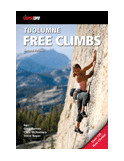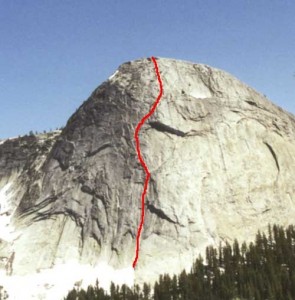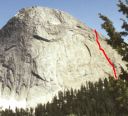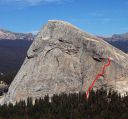Regular Route, Fairview Dome 5.9 |
||
Tuolumne Meadows, California USA | ||
| ||
|
Avg time to climb route: 6-8 hours
Approach time: 20 minutes Descent time: 40 minutes Number of pitches: 12 Height of route: 900' Overview
The Regular Route of Fairview is listed in 50 Classic Climbs of North America—“routes which ambitious climbers dream of doing.” There is no doubt that it is one of the climbs to dream about in Tuolumne Meadows. The route follows the longest steep line in Tuolumne and contains pitch after pitch of sustained and rewarding cracks. Views of Daff Dome and the Grand Canyon of the Tuolumne River are outstanding, surpassed only by the 360-degree panorama from the summit. The climbing features good pro, variable cracks and many options. Bring plenty of nuts as the line is loaded with perfectly tapered placements. Be ready to wait in a line and/or start the climb early (cold). There are few opportunities to pass slower parties. Sixty-meter ropes are recommended as they allow you to reach better belay options throughout the route.
Photos
- View all 37 photos of Regular Route as: Thumbnails | Slideshow
Climber Beta on Regular Route
Which SuperTopo guidebooks include a topo for Regular Route?
Find other routes like
Regular Route
History
Few mountaineers have the good fortune to stumble upon a climbing area as undeveloped as Tuolumne Meadows was in 1958. One such lucky person was Wally Reed, who felt like a child turned loose in a toy store as he puzzled over which should be the first big climb of the region. Reed had noticed half a dozen intriguing route possibilities, but his thoughts kept turning to the symmetrical 900-foot-high north face of Fairview Dome. On its steep north face were two long, conspicuous cracks; the right-hand one looked promising, for it shot up 300 feet and ended in broken rock. At the 450-foot level was a huge crescent-shaped ledge, and if it could be reached, the remainder of the route looked easier. Early in the summer of 1958 Reed met 19-year-old Chuck Pratt, who at that time had been climbing for less than a year, and asked him if he would be interested in making an attempt on the north face of Fairview. Pratt agreed immediately, flattered that a man who had labored on El Capitan with Warren Harding would ask him along on a new route. When Pratt arrived in Tuolumne and saw the marvelously direct route Reed had picked out, he knew at once it had the ingredients for a memorable climb. The first pitch of the climb went free and fast. But higher, as the cliff steepened, the two men were forced into direct-aid techniques. Since he had never done such extensive aid work, Pratt regularly tangled his feet in his aid slings, much to the amusement of Reed, who was completely at home on a long piton ladder. Twice it was necessary to belay in slings, an awkward technique Pratt had done only on practice climbs. So attentive were the men to their world of stone that when the sun disappeared behind a nearby ridge, they were caught by surprise. From a small ledge 400 feet above the ground, the pair hurriedly abandoned the face, satisfied that the route was feasible at least as far as what they called Crescent Ledge. It was not until August that the two climbers found time to return. They decided to carry bivouac gear on this attempt, which was a wise decision, for it was dusk when they reached Crescent Ledge, and the temperature quickly plunged to the freezing point. Insulated in their sleeping bags, the pair watched the moon rise over the Sierra crest and illuminate a world glowing with granite. Early the next morning Reed and Pratt began noticing subtle changes in the character of the rock. In the vicinity of Crescent Ledge, flakes and knobs began to appear, and the excited climbers stowed their aid slings and rapidly gained elevation. A four-foot ceiling that cut across the face at the 600-foot level looked formidable, but hidden, juglike holds permitted the obstacle to be free climbed easily. By noon, the two men had reached the rounded summit, amazed by the fact that they had covered the final 500 feet so easily. In the decades following Reed and Pratt’s first ascent, many more climbs have been established on the weathered knobby granite of Tuolumne, but none as long, and few so pleasing from afar. – Excerpt from Fifty Classic Climbs of North America, Steve Roper and Allen Steck. Strategy
This is one of the best climbs in Tuolumne, so expect a big line and slow parties. It’s common to have to return many times before getting a chance to get on the route, and coming mid-week does not help. Early season can be a good way to beat the crowds, but the compromise is that the whole crux section is flowing with water, which raises the grade a notch or two. Also, you must start the route from a receding snow field and it can be difficult trying to keep the rope(s) dry. Late season is another strategy, but often the temperatures have dropped and because the route gets nearly no sun the rock can be frigidly cold. The best strategy for fast teams is to start the route in the early afternoon after confirming that there are no slow parties above. For most folks, coming early and waiting in line is often the only option. Depending on the speed of the teams in front of you, this can be frustrating. Remember that returning another day is a smarter idea than starting late with slow parties above. The Regular Route eats up nuts, therefore a double set is recommended. In addition, there are no fixed rappel anchors so nuts are needed if retreating. Extra nuts, slings, and rappel rings or extra biners are a good idea for any team uncertain of their ability. 60m ropes allow much better belay options, especially for the first pitch. The crux on the first pitch requires good footwork on small polished edges and a great trick is to toprope some 5.10 faces the previous day, making the edges on the Regular Route seem huge. Almost every section of difficult climbing higher up can be mellowed by stemming and good footwork. The main safety rule on Fairview, like on any long route in Tuolumne, is NEVER to climb when puffy clouds are in sight—even a tiny one. They usually indicate later thunderstorms, which can easily be deadly high on the exposed dome. Windjackets and warm gear can be important on the cold north face. The best strategy is to harness and rack up at the car and carry everything with you, thereby avoiding the need to return to the start of the route and robbing marauding rodents of the chance to dine on your pack. Always bring headlamps and consider safety gear depending on your skill level and the season. Nights are freezing even in mid-summer. For strong parties who get an early start, consider finishing up the day on West Crack, right across the road on Daff Dome (Dome Across From Fairview). Retreat
Retreat with two ropes by leaving natural pro. At most places on the route, two or three nuts plus slings can be used to safely set a retreat anchor. With two 60m ropes you can reach the ground from the tree on the last rappel, otherwise you’ll need to either leave gear or downclimb. From Crescent Ledge you can rappel other routes with two ropes. The anchor conditions on these rappels are unknown.Approach
Park in an obvious six-car pullout in trees—the only pullout on the south side of the road—3.4 miles west of the Tuolumne Store and 4.2 miles east of Tenaya Lake. From the pullout, follow an obvious trail that heads directly from the left (southeast) corner of the parking lot toward the dome. Follow climbers’ trail signs; please do not stray from the trail. When the trail splits near the base of the dome, stay on the left trail for the Regular Route or the right trail for Lucky Streaks. Great Pumpkin starts 50 yards right of Lucky Streaks. Descent
There is only one descent route: walk south down the giant knobby slab of the dome. The descent is mostly 2nd class with one 3rd class section. Bring approach shoes unless you want to kill your toes! Climbing shoes are not needed for the descent.After getting down to the bottom, contour back right along the face until you reach the base of Lucky Streaks, then follow climbers’ signs back to your car. Everything You Need to Know About
Tuolumne Meadows
Search the internet for beta on
Regular Route
Other guidebooks that include info on Regular Route
|
Other Routes on Fairview Dome
|








